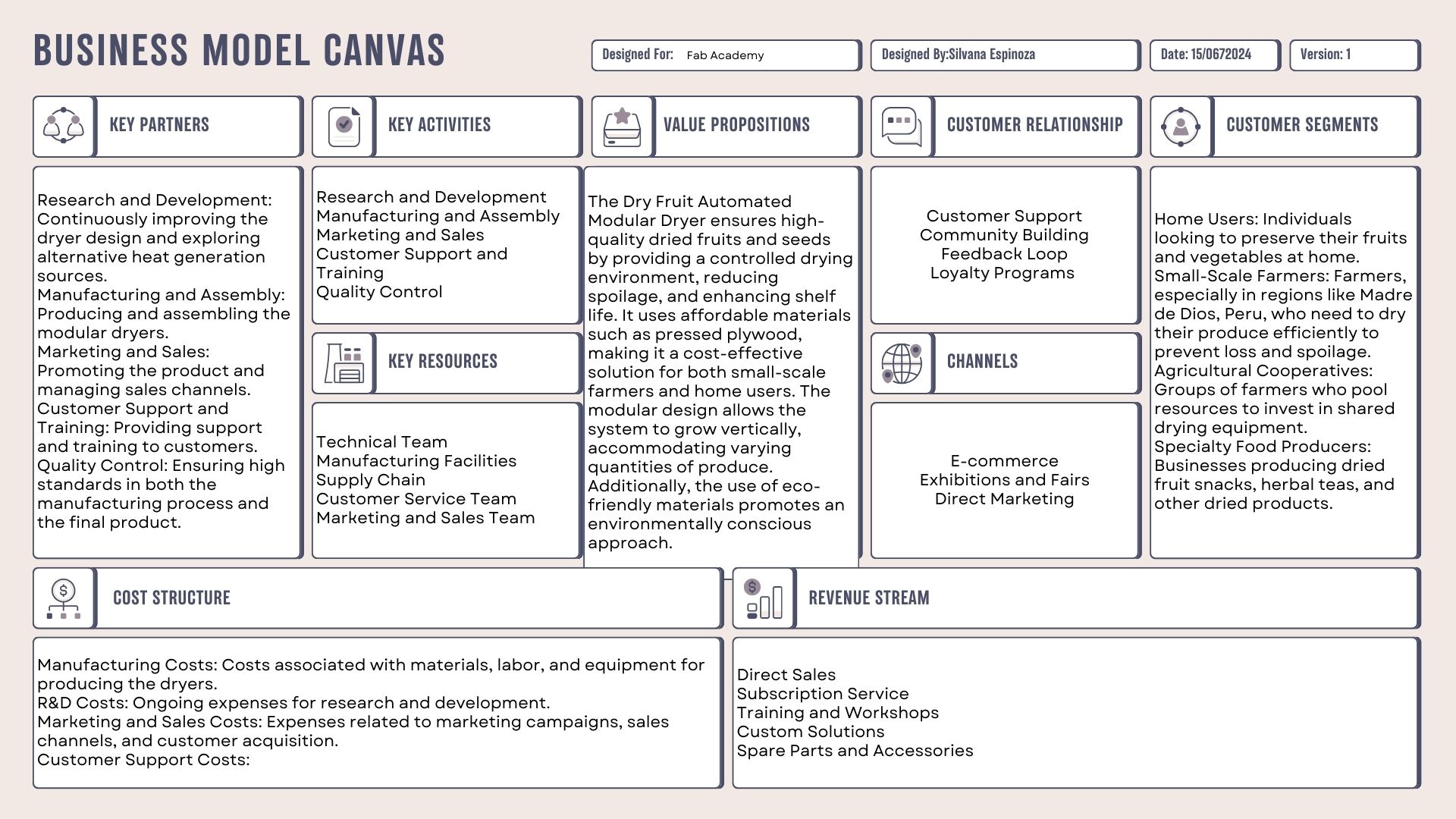Assignments
- Develop a plan for dissemination of your final project.
- Prepare drafts of your summary slide (presentation.png, 1920x1080) and video clip (presentation.mp4, 1080p HTML5, < ~minute, < ~10 MB) and put them in your root directory.
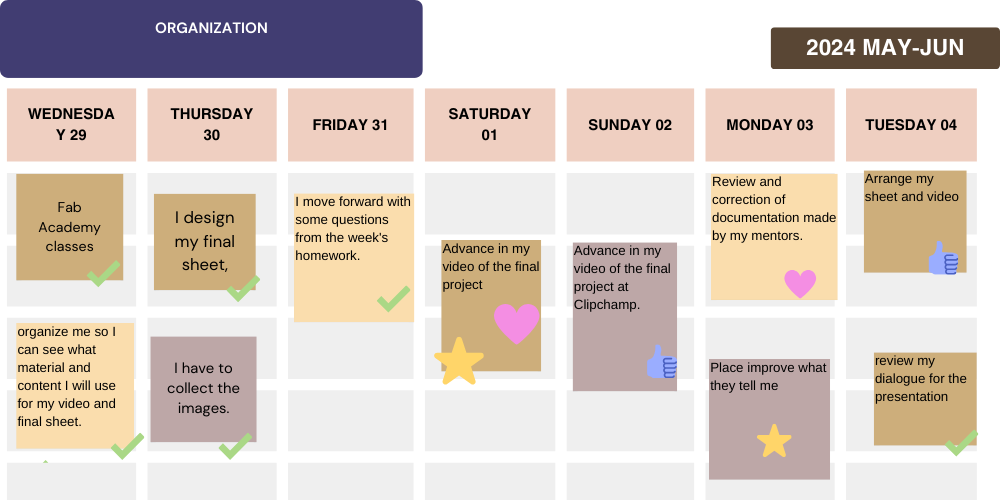
My final project
My final project idea was to make a fruit and seed dryer for the jungle of Peru one of the problems I saw on my trip to Madre de Dios where I had a workshop on agriculture and technology I could hear some problems of people living in these native communities, they have difficulties with respect to the cultivation and drying of their production in cocoa or copazu, which is dried outdoors and in days is ready, thinking of a solution I saw in being able to make automated drying modules where you can control the temperature and humidity depending on the type of seed or fruit that is in the comfort can be modified and adapted to any fruit or seed.
Abstract

The Dry Fruit Automated Modular Dryer for Fruits and Seeds provides a controlled environment where temperature and humidity can be adjusted to optimize the drying process. Designed to aid the native communities of Madre de Dios, Peru, this system efficiently dries products such as cocoa and copoazú, reducing damage from fungi and exposure to climatic conditions. The system maintains a temperature between 45°C to 60°C and regulates humidity to prevent mold, ensuring proper drying with uniform air circulation.
INTELLECTUAL PROPERTY
Regarding the intellectual property of the projects developed by FAB ACADEMY students, including my work, everything is supported by the MIT License. This license is characterized by its open source nature (open source), allowing anyone who visits my website the freedom to view, copy, test, modify, improve and merge my documentation without restrictions.
Everything you develop in the Fab Academy is for public use and has the Creative Commons license, this is the license that best adapts to what we develop in the ACademy, I will still show you what the process of some part of your project is like in Peru .
My project and that of my colleagues have the Creative Commons Attribution-NonCommercial-ShareAlike 4.0 International license
- Attribution — You must give appropriate credit , provide a link to the license, and indicate if changes were made . You may do so in any reasonable manner, but not in any way that suggests the licensor endorses you or your use.
- NonCommercial — You may not use the material for commercial purposes .
- ShareAlike — If you remix, transform, or build upon the material, you must distribute your contributions under the same license as the original.

After adjusting the values in the Mill Raster 2D setup, I proceeded to perform the calculation to obtain the updated results. By editing these values, I was able to refine the milling parameters and obtain a more accurate and efficient machining process. This modification in the configuration allowed me to better adapt the milling strategy to the specific needs of my project, thus improving the quality and accuracy of the final result.
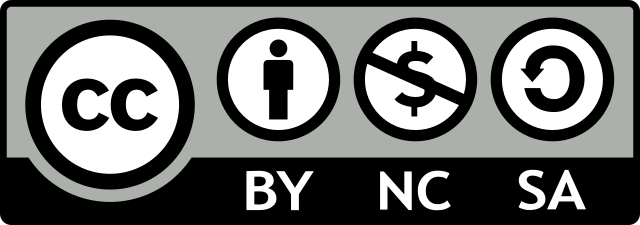
Register an invention patent in Peru
If you have invented a novel product or procedure, you can apply for an invention patent from Indecopi. With this title, you can protect your invention as long as it represents a contribution to the state of the art in the country. In general, invention patents protect the results of research,
development and technological innovation (R&D&I) processes.
Product inventions can be compounds, compositions, tools, devices, machinery, equipment, apparatus, among others; while procedural inventions refer to processes, methods and the like.
Every invention patent has protection for a non-renewable period of 20 years, counted from the date of submission of its application. After this time, the invention will enter the public domain and may be used freely by other natural or legal persons.
Search history of a brand
linkBefore registering your trademark, it is recommended that you review and interpret the results of searches for phonetic or figurative antecedents of the elements that your trademark has, to verify that there are no other trademarks that have already been registered or requested, or are the same or similar.
Intellectual Property Considerations
Novelty and Non-Obviousness
- Ensure that the modular design and specific combination of components are novel and non-obvious.
- Define the scope of the invention clearly in the claims section, including the modular design, configurations of the modules, and the programming logic.
- Provide a comprehensive description of the invention, including technical specifications, assembly process, and programming logic.
- Highlight the practical applications and advantages of the invention
Manufacturing Processes:
The construction of the Dry Fruit system involves several manufacturing processes to ensure precision and functionality. The structure is designed in Fusion 360, with plans drafted in AutoCAD for CNC machining. The electronic circuit boards are designed and milled, followed by soldering the components. Laser cutting is employed to create divisions and specific parts of the structure, while 3D printing is used to fabricate supports for internal divisions. Vinyl cutting is used for logos and labels, adding a professional finish to the dryer. The assembled system includes a glass top for observation, providing both functionality and aesthetic appeal. These processes together contribute to the high-quality, efficient construction of the modular dryer.
BUSINNESS MODEL
Value Proposition
- Ensures high-quality dried fruits and seeds by providing a controlled drying environment, reducing spoilage and enhancing shelf life.
- Uses recycled components and affordable materials, making it a cost-effective solution for both small-scale farmers and home users.
- he modular design allows the system to grow vertically, accommodating varying quantities of produce.
- Utilizes eco-friendly materials, promoting an environmentally conscious approach.
Customer Segments
- Home Users: Individuals looking to preserve their fruits and vegetables at home.
- Small-Scale Farmers: Farmers, especially in regions like Madre de Dios, Peru, who need to dry their produce efficiently to prevent loss and spoilage.
- Agricultural Cooperatives: Groups of farmers who pool resources to invest in shared drying equipment.
- Specialty Food Producers: Businesses producing dried fruit snacks, herbal teas, and other dried products.
Revenue Streams:
- Direct Sales: Selling the Dry Fruit dryer units to home users, farmers, and cooperatives.
- Subscription Service: Offering a subscription service for maintenance, software updates, and support.
- Training and Workshops: Providing training sessions and workshops on the effective use of the dryer, as well as best practices in drying various types of produce.
- Custom Solutions: Designing custom modular drying systems tailored to specific customer needs
- Spare Parts and Accessories: Selling spare parts, accessories, and additional modules for expanding the system.
Channels:
- E-commerce: Selling directly through an online store. Local Distributors: Partnering with local agricultural supply stores and cooperatives
- Exhibitions and Fairs: Showcasing the product at agricultural and food industry exhibitions and fairs.
- Direct Marketing: Reaching out to potential customers through direct marketing campaigns, including email and social media marketing.
Key Resources
- Engineers and designers responsible for R&D, product design, and improvement.
- Equipment and facilities for CNC machining, laser cutting, 3D printing, and assembly.
- Reliable suppliers for components and materials.
Cost Structure:
- Costs associated with materials, labor, and equipment for producing the dryers.
- Ongoing expenses for research and development. Marketing and Sales Costs: Expenses related to marketing campaigns, sales channels, and customer acquisition.
- Expenses for shipping and distribution.
SLIDE AND VIDEO CLIP
I made the design of my final sheet in Canva, it is a good platform to create beautiful canvas images.
For my video I used Clipchamp from Microsoft, it was easy to use and helped me a lot in editing my video.

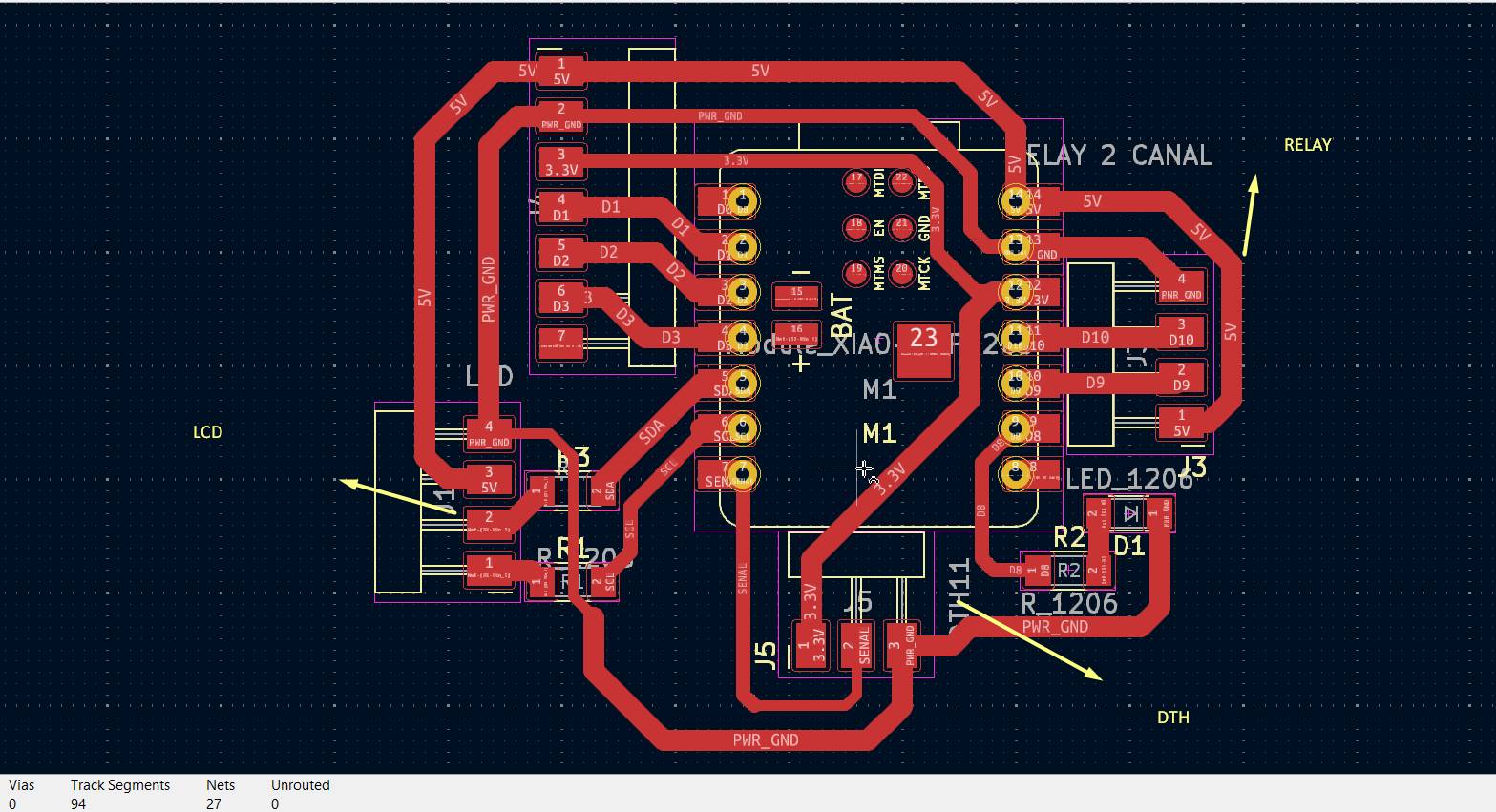

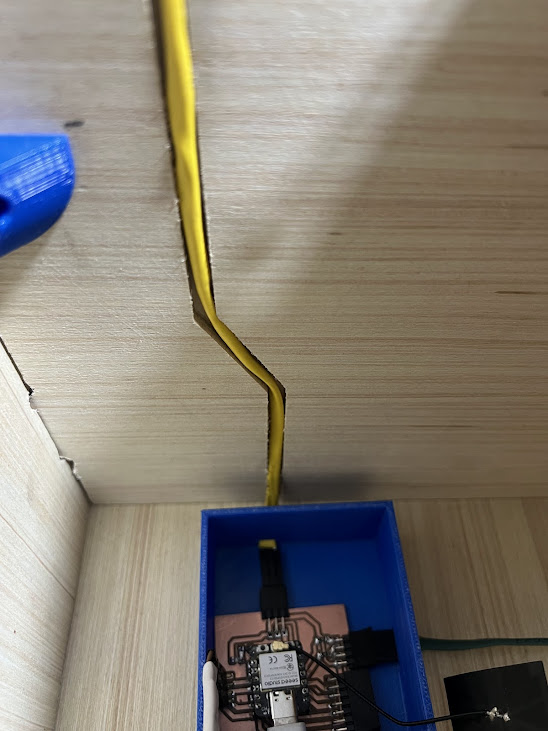





DryFruit by Silvana Espinoza Gomez is licensed under Creative Commons Attribution-NonCommercial-ShareAlike 4.0 International
Conclusion
- In Fab Academy and the MIT License, which promotes open-source development, it is essential to weigh the benefits of patenting against the collaborative and open-source ethos of Fab Academy.
- The MIT License allows anyone to view, copy, test, modify, improve, and merge your work without restrictions.
- This approach can foster innovation, collaboration, and community support, potentially leading to further improvements and broader adoption of your invention.
- The decision to patent or remain open source should align with your goals and values. If you choose to patent, you can still keep some aspects open source or offer different licensing models. If you decide to keep the project open source like I will, you can focus on community-driven development and support, benefiting from shared knowledge and collective advancement.

